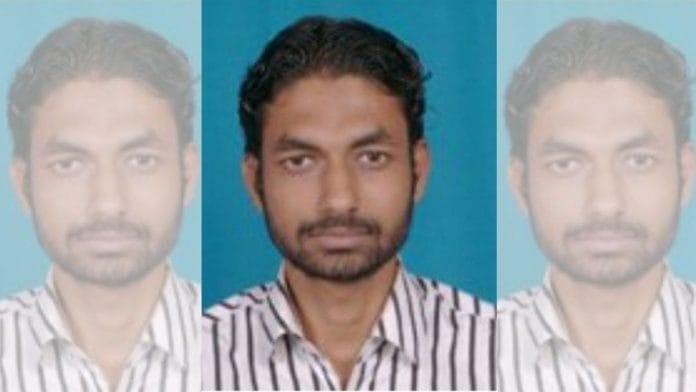New Delhi: Indian Mujahideen (IM) operative and IED expert Tehsin Akhtar, who is lodged in Tihar jail, is in news again.
A mobile handset has been seized from Akhtar’s barrack in jail No. 8, which was allegedly used to send Telegram messages claiming responsibility for parking an SUV with 20 gelatin sticks outside industrialist Mukesh Ambani’s Mumbai residence on 25 February and also for the Israel embassy blast on 29 January. The messages were allegedly sent by a little-known organisation, Jaish-ul-Hind.
Jail No. 8 in Tihar houses prisoners, including those from Indian Mujahideen and al Qaeda, who have been sentenced for cases of terror.
According to the police, Jaish-ul-Hind was created inside the Tihar jail.
Also read: Hizbul chief Salahuddin, Indian Mujahideen’s Bhatkal among 18 designated as terrorists
Who is Tehsin Akhtar?
Akhtar, alias Monu, is known for his alleged involvement in a series of blasts that shook the country since 2010.
He was convicted in 2016 for his alleged role in the 2013 Hyderabad twin bombings that killed at least 13 people and injured over 100 others. The attack was carried out using IEDs kept on bicycles stationed in Dilsukhnagar, one of Hyderabad’s busiest commercial areas.
In March 2014, Akhtar, then 24-year-old, was arrested from Naxalbari in Darjeeling district of West Bengal by the Special Cell of Delhi Police. According to the police, Akhtar was found hiding near the India-Nepal border in Panitanki area of Naxalbari.
The announcement of his arrest had come just three days after the arrest of top IM operative and Pakistani national Zia-ur-Rehman alias Waqas from Rajasthan, and security agencies believed this to be a major setback for the outfit.
Akhtar, according to the police, became the operational chief of Indian Mujahideen after the arrest of its co-founder Mohammad Zarar Siddibappa alias Yasin Bhatkal from India-Nepal border in August 2013.
Bhatkal is said to have informed the investigators at the time of his arrest on 29 August 2013 that Akhtar is the India head of IM and deals directly with Karachi-based operative, Riyaz Bhatkal. He was said to have been managing modules across India. The NIA had subsequently announced a reward of Rs 10 lakh on Akhtar.
Engineering student to ‘bomb expert’
Akhtar scored 48 per cent in Class 12 CBSE board exams, after which he enrolled himself for a diploma in civil engineering at Maulana Azad National Urdu University in Bihar’s Darbhanga.
According to the interrogation report, Akhtar met Gayur Jamali, another IM operative, in 2009 at a library near Al-Hira Public School in Darbhanga, where they would discuss different interpretations of ‘jihad’ in Quran.
Akhtar was introduced to Yasin Bhatkal for the first time by Jamali in Feb-March 2010. It was at a hideout in a jungle in Darbhanga that Akhtar learnt and conducted experiments on different methods of preparing IED (Improvised Explosive Device), using various chemicals — Nitric Acid, Sulphuric Acid, H2O2, Potassium Permanganate etc.
Known as a “tech-savvy bomb expert”, Akhtar is also the alleged mastermind behind the serial blasts that rocked Patna on 27 October 2013 during Narendra Modi’s rally there. Five persons were killed and over 83 injured in the blasts.
He is also known for his alleged involvement in the bombing of Varanasi’s Sheetla Ghat in 2010, cooker bomb blast outside Jama Masjid in 2010, serial blasts in Mumbai in 2011, and Pune blasts of 2012.
Akhtar along with Yasin Bhatkal, and IM operatives Asadullah Akhtar alias Haddi, Zia-ur-Rehman and Ajaz Shaikh were convicted by a special NIA court in 2016 for their alleged involvement in the 2013 Hyderabad blasts.
Making way to the top
Akhtar belongs from Bihar’s Samastipur and was allegedly inducted into IM’s Darbhanga module around 2011-2012.
According to the police, Akhtar impressed and earned the trust of the Bhatkal brothers, Riyaz and Yasin, very soon and made his way to the top, after which he allegedly began managing all modules in India after Yasin’s arrest.
In 2010, Akhtar was entrusted with the crucial task of receiving Waqas and Asadullah Akhtar from Pakistan, who entered India through Kathmandu.
A young Akhtar was said to have been eager, effective and highly motivated, and soon learnt to build IEDs after becoming Yasin’s protégé.
He was allegedly in charge of inducting youths into IM and tapped organisations like SIMI (Students Islamic Movement of India) for manpower.
Also read: ‘No matter of doubt’: IM’s Ariz Khan convicted for killing inspector MC Sharma at Batla House







And non-Muslims are labelled as “Islamophobics” if they express apprehension about this violent and divisive attitude of some Muslims. So-called Islamophobia is the consequence of Islamic terrorism.
Here we go again. Great chef, engineer by day social worker by night…blah blah.
These mawali maskin malecha tribal fundamentalist wahabi have run its course.
In next 5-10 years we have to weed out every single one of them and send them back to where they came from.
A secular nation with rich culture and heritage has no place for primitive tribalism.
Their taqiya has to be responded with full force. Otherwise they will turn this beautiful land into Stone Age harum.